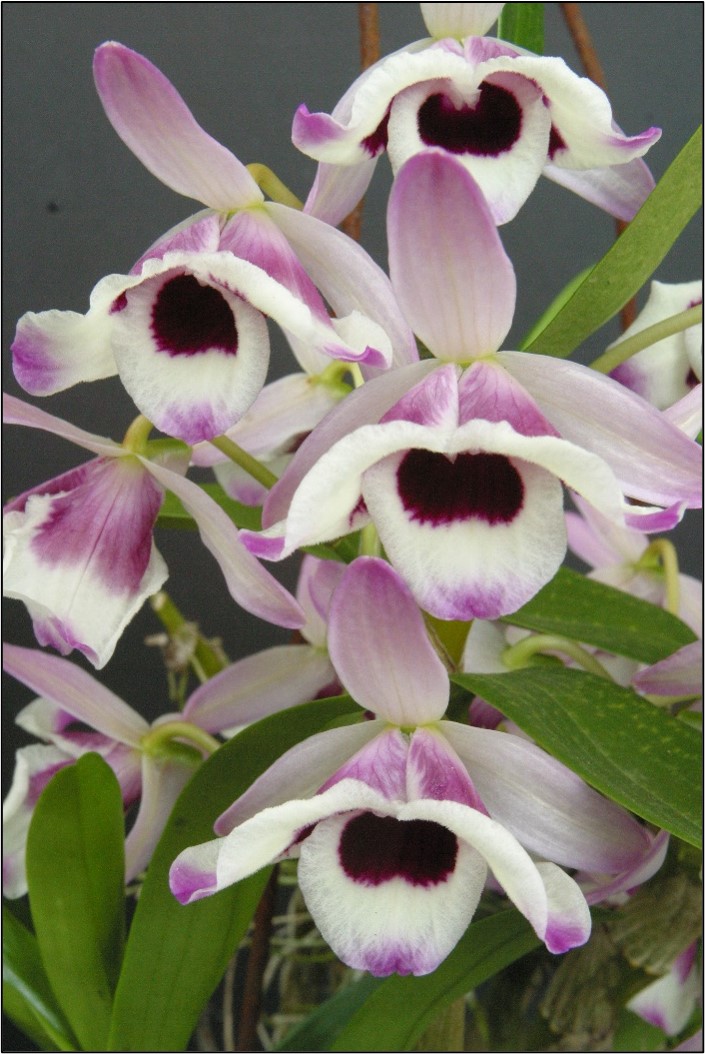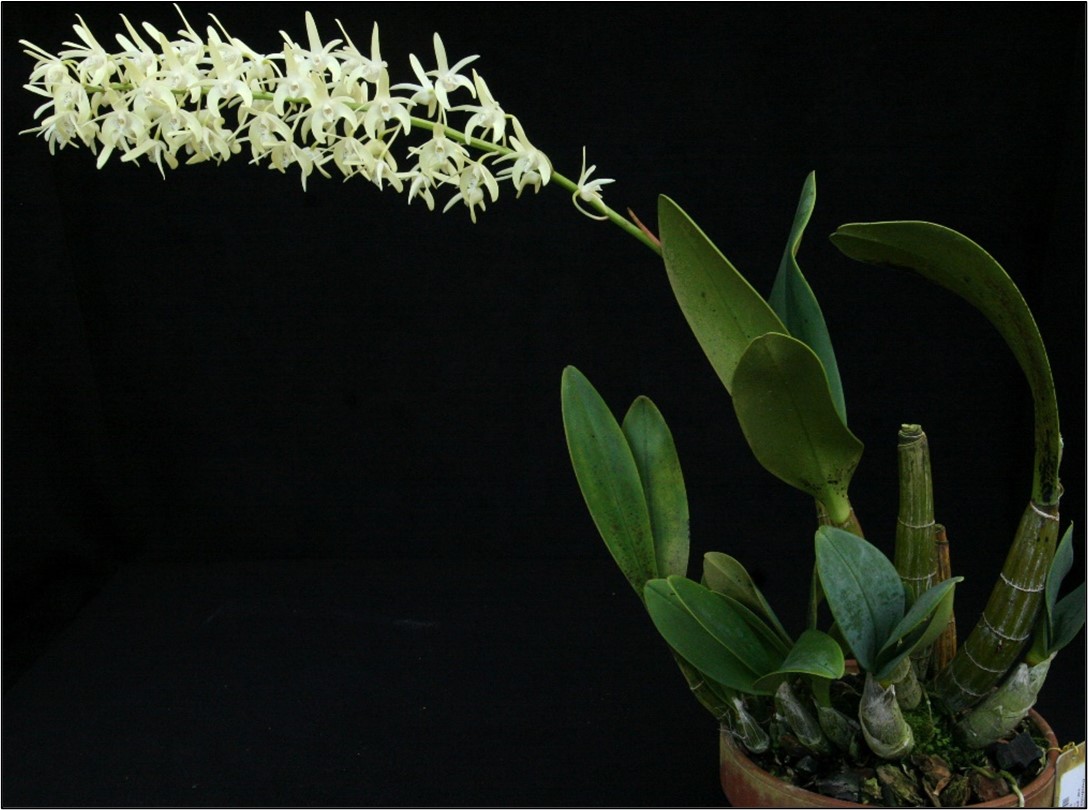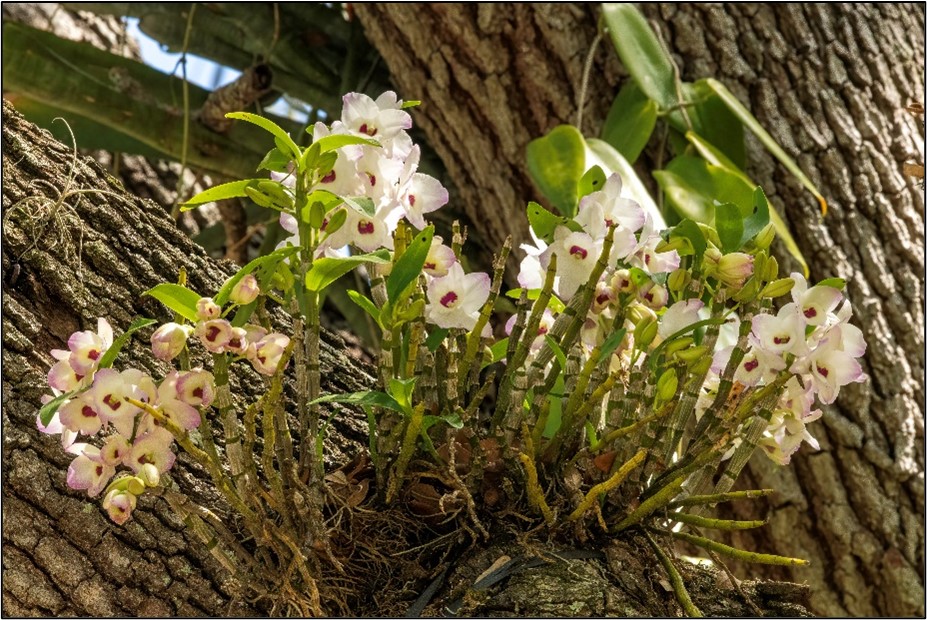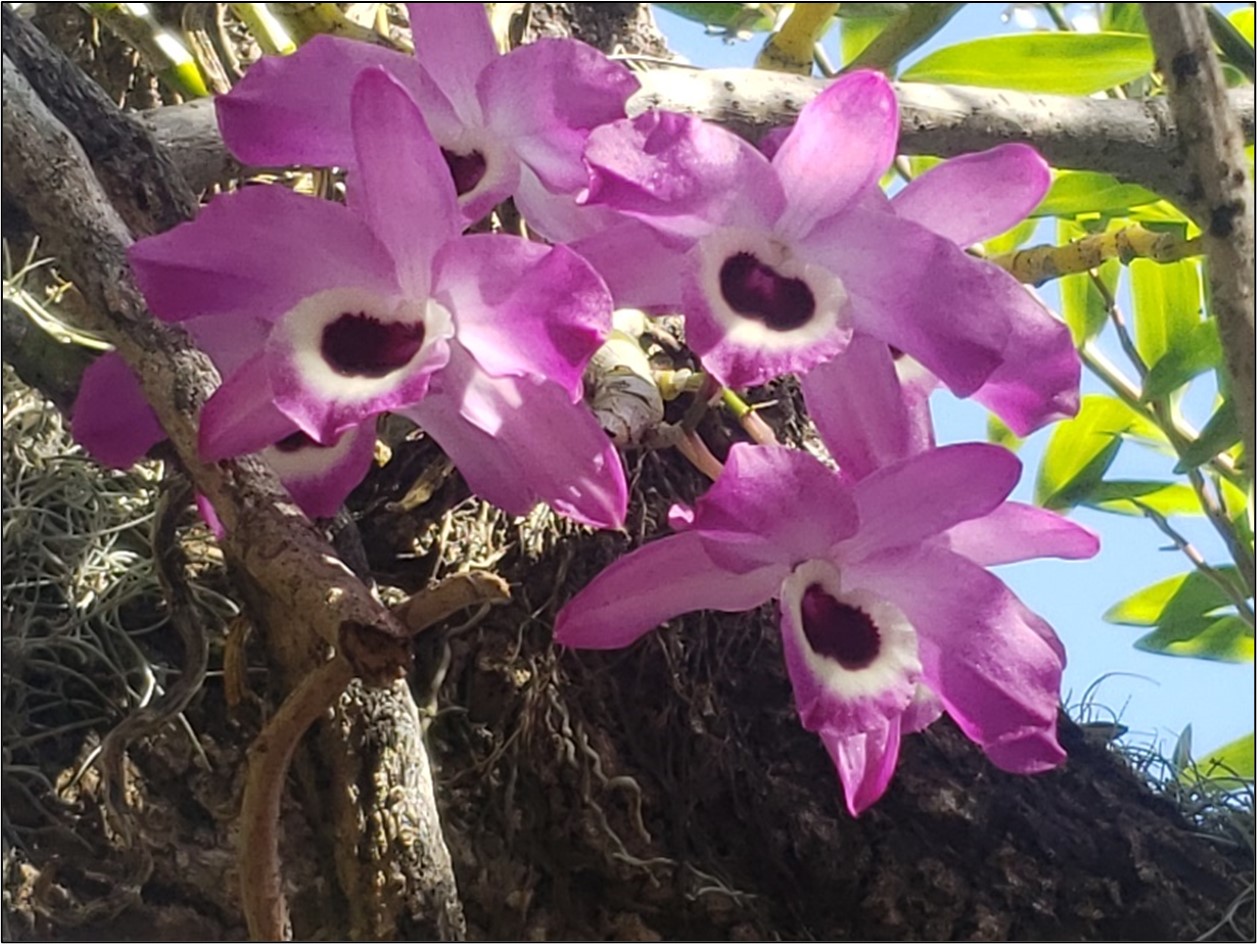Written by Shawn McCourt, Ph.D. Plant Records Keeper

Dendrobium nobile var. cooksonianum in MSBG’s greenhouse collection.
When most people think of spring flowers, they tend to think daffodils, tulips, hyacinths, cherry blossoms, or azaleas, but here at Marie Selby Botanical Gardens, we’re all about epiphytes, or plants that grow on other plants and trees. For us, the surest sign of spring at the Downtown Sarasota campus is the blooming of an epiphytic (and lithophytic) orchid, the Noble Dendrobium (Dendrobium nobile) and its hybrids and cultivars. This charismatic species hails from a wide swath of Asia, including Nepal and Tibet in the Himalayas to India, China, Myanmar, Thailand, Laos, Cambodia, and Vietnam where it grows in both lowland and mountain forests, often on mossy rocks and trees. It is typically an upright or slightly recumbent plant with strap-shaped, deciduous or semi-deciduous leaves. The thin stems are pseudobulbs called “canes” and function as water and nutrient storage as well as support for the plant. All 1,500 or so Dendrobium species are classified as either “hard-caned” or “soft-caned”. The “hard-caned” types are typically evergreen plants from warmer regions, and produce long sprays of flowers from the top of the cane, as Dendrobium speciosum does; while the “soft-caned” types like Dendrobium nobile and its kindred are deciduous plants from more temperate or mountainous regions, and lose most, if not all, of their leaves when the weather gets cold. Their blooms are produced from nodes along the sides of both leafy and leafless canes in spring following the cold spell. The deciduous nature of nobile-type Dendrobiums has enabled them to survive both drought and the periodic freezes we get every 10 years or so here in Sarasota. As a result, they are one of the more abundant epiphytes we have planted in the trees on our grounds.

“Hard-caned” Dendrobium speciosum in MSBG’s greenhouse collection
Dendrobium is a commercially important genus from a horticultural perspective; however, many Dendrobium species, including Dendrobium nobile, have been used for thousands of years in traditional East and South Asian cultures for the treatment of a wide variety of inflammatory disorders.
The Chinese consider “Shihu” (Dendrobium) to be one of the fifty fundamental herbs used to treat all kinds of ailments and to increase longevity. The Japanese have, since antiquity, considered a single species, Dendrobium moniliforme (“Fu-ran” or “Sekkoku”), to be “the orchid that gives long life to men” (Cakova 2017).
Recent studies have revealed many Dendrobium species to contain active biochemical compounds that have anti-oxidative and anti-inflammatory properties. These and other compounds extracted from Dendrobium nobile have shown great promise in the treatment of age-related pathologies and progressive neurological disorders like Alzheimer’s and dementia due to neuroprotective effects (Cakova 2017; Zhang et al. 2017; Lam et al. 2015). The antioxidant and anti-inflammatory properties of cool-growing Dendrobiums like D. nobile may be a phytochemical response to both the low water stress and low temperature stress that the plants encounter in their native habitats; and for thousands of years, humans have recognized and harnessed these properties to treat illness and extend life. Whether your interest is medical, ethnobotanical, horticultural, or purely visual, come see the showy display of Dendrobium nobile plants in the trees everywhere at our Downtown Sarasota campus this week before they fade. Just remember to look up!

Dendrobium nobile Himezakura ‘Sanokku’ blooming in a live oak in the south parking lot at the Downtown Sarasota campus (Photo by Aaron Fink).

Hybrid Dendrobium nobile currently blooming on a Tabebuia tree beside the Carriage House at Selby Gardens’ Downtown Sarasota campus. (Photo by Shawn McCourt)
Resources:
American Orchid Society (2019). Dendrobium. Sec. Dendrobium. Retrieved 9 March 2021 from https://www.aos.org/orchids/orchids-a-to-z/letter-d/den-sec-dendrobium.aspx.
Cakova, V., Bonte, F., & Lobstein, A. (2017). Dendrobium: Sources of Active Ingredients to Treat Age-Related Pathologies. Aging and Disease. 8(6): 827–849. Retrieved 9 March 2021 from https://www.ncbi.nlm.nih.gov/pmc/articles/PMC5758354/.
Lam, Y., Ng, T. B., Yao, R. M., Shi, J., Xu, K., Sze, S. C., & Zhang, K. Y. (2015). Evaluation of Chemical Constituents and Important Mechanism of Pharmacological Biology in Dendrobium Plants. Evidence-based Complementary and Alternative Medicine. eCAM, 2015, 841752. Retrieved 9 March 2021 from https://www.ncbi.nlm.nih.gov/pmc/articles/PMC4402476/.
Yamamoto, Jiro (1993). Cultural Requirements for Dendrobium nobile. In: Growing Orchids: A Cultural Handbook. American Orchid Society, Coral Gables, FL. Retrieved 10 March 2021 from https://akatsukaorchid.com/content/DendrobiumNobile.pdf.
Zhang, W., Wu, Q., Lu, Y. L., Gong, Q. H., Zhang, F., & Shi, J. S. (2017). Protective effects of Dendrobium nobile Lindl. alkaloids on amyloid beta (25-35)-induced neuronal injury. Neural Regeneration Research, 12(7), 1131–1136. Retrieved 9 March 2021 from https://www.ncbi.nlm.nih.gov/pmc/articles/PMC5558493/.
